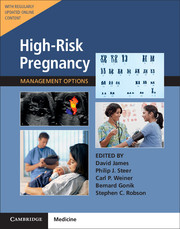Book contents
- Frontmatter
- Contents
- List of Contributors
- Preface
- Section 1 Prepregnancy Problems
- Section 2 Early Prenatal Problems
- Section 3 Late Prenatal – Fetal Problems
- Section 4 Problems Associated with Infection
- Section 5 Late Pregnancy – Maternal Problems
- 30 Substance Misuse in Pregnancy
- 31 Medication in Pregnancy
- 32 Hypertension in Pregnancy
- 33 Cardiac Disease in Pregnancy
- 34 Respiratory Disease in Pregnancy
- 35 Anemia and White Blood Cell Disorders in Pregnancy
- 36 Hematological Malignancies in Pregnancy
- 37 Thrombocytopenia and Bleeding Disorders in Pregnancy
- 38 Disorders of Coagulation in Pregnancy
- 39 Autoimmune Disease in Pregnancy
- 40 Diabetes in Pregnancy
- 41 Thyroid Disease in Pregnancy
- 42 Pituitary and Adrenal Disease in Pregnancy
- 43 Gastrointestinal and Liver Diseases in Pregnancy
- 44 Neurologic Complications in Pregnancy
- 45 Renal Disorders in Pregnancy
- 46 Spine and Joint Disorders in Pregnancy
- 47 Skin Disease in Pregnancy
- 48 Malignant Disease in Pregnancy
- 49 Pregnancy After Transplantation
- 50 Trauma in Pregnancy
- 51 Mental Health Disorders in Pregnancy
- Section 6 Late Prenatal – Obstetric Problems
- Section 7 Postnatal Problems
- Section 8 Normal Values
- Index
38 - Disorders of Coagulation in Pregnancy
from Section 5 - Late Pregnancy – Maternal Problems
- Frontmatter
- Contents
- List of Contributors
- Preface
- Section 1 Prepregnancy Problems
- Section 2 Early Prenatal Problems
- Section 3 Late Prenatal – Fetal Problems
- Section 4 Problems Associated with Infection
- Section 5 Late Pregnancy – Maternal Problems
- 30 Substance Misuse in Pregnancy
- 31 Medication in Pregnancy
- 32 Hypertension in Pregnancy
- 33 Cardiac Disease in Pregnancy
- 34 Respiratory Disease in Pregnancy
- 35 Anemia and White Blood Cell Disorders in Pregnancy
- 36 Hematological Malignancies in Pregnancy
- 37 Thrombocytopenia and Bleeding Disorders in Pregnancy
- 38 Disorders of Coagulation in Pregnancy
- 39 Autoimmune Disease in Pregnancy
- 40 Diabetes in Pregnancy
- 41 Thyroid Disease in Pregnancy
- 42 Pituitary and Adrenal Disease in Pregnancy
- 43 Gastrointestinal and Liver Diseases in Pregnancy
- 44 Neurologic Complications in Pregnancy
- 45 Renal Disorders in Pregnancy
- 46 Spine and Joint Disorders in Pregnancy
- 47 Skin Disease in Pregnancy
- 48 Malignant Disease in Pregnancy
- 49 Pregnancy After Transplantation
- 50 Trauma in Pregnancy
- 51 Mental Health Disorders in Pregnancy
- Section 6 Late Prenatal – Obstetric Problems
- Section 7 Postnatal Problems
- Section 8 Normal Values
- Index
Summary
Introduction
The human hemostatic system involves a number of complex and highly regulated processes. In turn, these processes are interwoven with other important systemic and cellular systems (e.g., immune, hematologic, nutritional/gastrointestinal, and cardiovascular) and are thus sensitive to myriad biologic influences and events. During states of blood vessel injury the hemostatic system must be quick, localized, and reliable. Unfortunately, there are many inherited, acquired, and physiologic conditions that can disrupt the hemostatic system and lead to suboptimal or inappropriate clot formation. The chapter focuses on thrombophilias and nonphysiologic thrombi (thrombosis not required for hemostasis) as they relate to the pregnant woman.
Several national organizations, including the American College of Obstetricians and Gynecologists (ACOG) and the American College of Chest Physicians (ACCP) have published guidelines regarding thrombosis and pregnancy. These will be referred to throughout this chapter.
Hemostatic System
In the normally functioning hemostatic system, coagulation is mediated by a cascade of extracellular clotting factors and cellular components that seal breached endothelium with fibrin–platelet plugs. This process can be thought of as having four essential phases:
1. Platelet plug formation, mediated by exposure of endothelial proteins, including von Willebrand factor (vWF), which bind and recruit platelets to the site of injury.
2. Clotting cascade and fibrin plug formation, initiated by endothelial tissue factor binding to factor VII and leading, via a number of redundant pathways, to thrombin-mediated conversion of fibrinogen to fibrin.
3. Termination of clot formation by endogenous anticoagulants, including proteins C and S.
4. Fibrinolysis, during which plasmin degrades the cross-linked fibrin polymers, resulting in the formation of fibrin degradation products (FDPs).
Effect of Pregnancy on Hemostasis
The normal physiology of pregnancy causes important changes in the hemostatic system, resulting in a hypercoagulable state. These changes include:
• decrease by 60–70% in the level of protein S, with nadir around delivery
• increases by 20–1000% in fibrinogen, vWF, factors II, VII, VIII, IX, and X levels
• increases in the levels of antifibrinolytic plasminogen activation inhibitor 1 (PAI-1) and PAI-2
• progressive platelet activation
Although these changes may have evolved to protect the mother from excessive blood loss at delivery, they also increase the likelihood of pathologic thrombus formation.
- Type
- Chapter
- Information
- High-Risk Pregnancy: Management OptionsFive-Year Institutional Subscription with Online Updates, pp. 1085 - 1107Publisher: Cambridge University PressFirst published in: 2017



